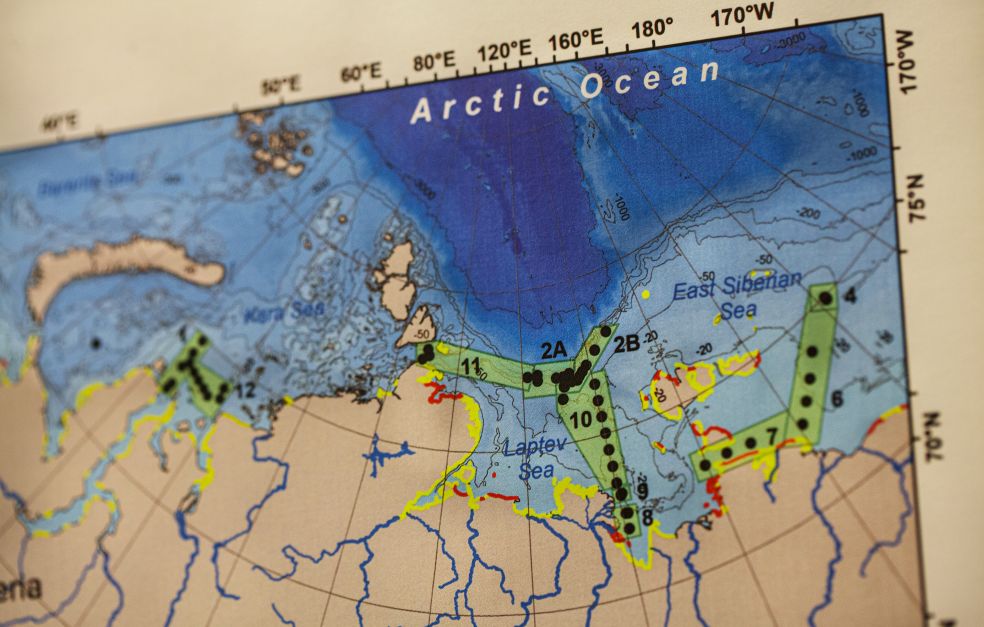Deep in the Arctic Ocean, the seabed is frozen, but now that the permafrost is thawing, large quantities of methane gas may rise to the surface. Birgit Wild wants to find models to predict what this means for the climate.
Birgit Wild
Dr. of Natural Science
Wallenberg Academy Fellow 2023
Institution:
Stockholm University
Research field:
Changes in the carbon and nitrogen cycles in the Arctic that impact greenhouse gases.
When large ice sheets melted at the end of the last ice age, sea levels surged. Large swathes of the ice-covered Arctic were submerged. Now the sea temperature is rising, causing permafrost on the seabed to thaw at far faster rates than on land.
Organic material and large amounts of methane gas are frozen in the seabed. There are fears that the gas, which causes significantly more warming of the atmosphere than carbon dioxide, will rise to the surface and create a climate change tipping point.
“We know that there is a large amount of methane gas in the climate system, but we don’t yet know where it all comes from. That’s why we need to understand whether the thawing of underwater permafrost will increase Arctic methane emissions,” says Wild, a researcher at Stockholm University.
Impacts of previous changes in the climate
It is extremely well supported by scientific evidence that methane emissions are accelerating due to existing human-caused climate impacts. What makes this complex is that they could also be accelerating due to events triggered by climate changes that occurred as far back as 12,000 years ago.
“An historic climate change may have started a chain reaction that continues to the present day. This could be a critical addition to the climate change that we ourselves have caused. This complex behavior of essentially natural sources is what we are trying to understand.”
Wild’s research aims to create models that show the impact thawing permafrost under the sea has on the climate. Answers are being sought in drill samples collected from expeditions to the Arctic Ocean.
Her most recent expedition was to the East Siberian Arctic Ocean in 2020, in which researchers from several universities participated. During six grueling weeks at sea in severe cold, the team worked hard to obtain as many samples as possible.
“Ice is a major challenge, especially on expeditions with ships that aren’t icebreakers. You have to adjust your itinerary on a daily basis according to the weather. Some of the team see their dreams crushed, while others will hopefully be fulfilled.”
The drill samples she works with today, however, come from expeditions made between 2011 and 2015. Some of them have been analyzed before, but a lot of knowledge can still be extracted from the frozen material.
A three-part project
When Wild opens the door of one of the large freezers in the institution’s basement, she asks the photographer to be quick. The samples she picks up contain organic material that date back more than 150,000 years. If they thaw, microbes will wake up and start to eat the material and make it unusable for research.
The research project is conducted in several stages. First, drill samples are thawed in a lab environment that mimics the subsurface environment as much as possible.
“As the material thaws, bacteria and microbes that produce methane gas come back to life.”
The samples are then exposed to salt water (among other things) to see how this affects the bacteria’s methane production. At the same time, the researchers look at how well the material filters methane gas that is formed.
“This is more difficult because it only happens under natural conditions. So, we measure special biomarkers that are created by micro-organisms in the material that live on methane. This allows us to estimate how much methane is filtered.”
Finally, the team combines the findings with existing data in a model that predicts climate impacts from thawing permafrost under water.
“The model we’re developing is unique in that it also considers irregularities in sediment, such as fractures, which can have a significant impact on methane fluxes.”
The goal is for the model to provide guidance in work on global strategies to mitigate climate change. But it is not only the thawing permafrost below the surface that affects the Arctic Ocean. As sea ice retreats, coastal erosion clouds the water near land and prevents the uptake of carbon dioxide. There is also considerable acidification of the sea in these areas.
“It may seem like an impossible puzzle to solve, but we scientists love impossible puzzles. The more difficult the task, the more interested we are.”
Creative work
Working as a researcher has been a dream of Wild’s since she was eleven. She grew up in Vienna and was heavily influenced by the environmental debate of the time. After completing her doctorate, she applied to Stockholm University for a research position.
“What I like most about the work are the creative aspects – when we compile data we’ve obtained and analyze and understand the results. It’s also important to me that our research makes a difference to society.”
There are a large number of contributing factors behind the increased levels of greenhouse gases in the atmosphere. We have some serious homework to do before we fully understand them.
The climate models that Wild contributes to could be decisive in addressing ongoing climate change.
“We need to find ways to predict what will happen and then act on it. If we are to succeed, we must reduce the amount of greenhouse gases released into the atmosphere and find ways to capture those we have already emitted.”
Text Magnus Trogen Pahlén
Translation Nick Chipperfield
Photo Magnus Bergström






